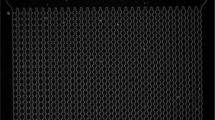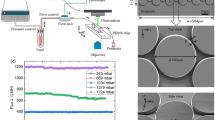Abstract
Here we present the liquid–liquid microflows and dispersion rules in micro-sieve devices with two different sized pores. The flow pattern, flux distribution and droplet size were investigated to discuss the effect of pore size deviation. Three flow patterns including drip** flow from a single active pore, drip**–drip** flow and drip**–jetting flow from two active pores were identified. A modified active pore model based on a pressure drop balance has been established. The model can predict the transition from a single active pore flow regime to a two active pore flow regime very well. In the latter regime, interactions between the small and large pores can result in drip**–drip** flow at low trans-pore flux and drip**–jetting flow at high trans-pore flux. Controlling the flow pattern in drip**–drip** flow is favorable to decreasing droplet polydispersity.












Similar content being viewed by others
References
Ambrosone L, Murgia S, Cinelli G, Monduzzi M, Ceglie A (2004) Size polydispersity determination in emulsion systems by free diffusion measurements via PFG–NMR. J Phys Chem B 108:18472–18478
Choi JH, Lee SK, Lim JM, Yang SM, Yi GR (2010) Designed pneumatic valve actuators for controlled droplet breakup and generation. Lab Chip 10:456–461
Chu LY, Utada AS, Shah RK, Kim JW, Weitz DA (2007) Controllable monodisperse multiple emulsions. Angew Chem Int Ed 46:8970–8974
Cramer C, Fischer P, Windhab EJ (2004) Drop formation in a co-flowing ambient fluid. Chem Eng Sci 59:3045–3058
Geerken MJ, Lammertink R, Wessling M (2007) Interfacial aspects of water drop formation at micro-engineered orifices. J Colloid Interface Sci 312:460–469
Gijsbertsen-Abrahamse AJ, van Lierop R, van der Smana RGM, van der Padt A, Boom RM (2002) Analysis of droplet formation and interactions during cross-flow membrane emulsification. J Membr Sci 204:125–137
Gijsbertsen-Abrahamse AJ, van der Padt A, Boom RM (2003) Influence of membrane morphology on pore activation in membrane emulsification. J Membr Sci 217:141–150
Gijsbertsen-Abrahamse AJ, van der Padt A, Boom RM (2004) Status of cross-flow membrane emulsification and outlook for industrial application. J Membr Sci 230:149–159
Jullien MC, Ching M, Cohen C, Menetrier L, Tabeling P (2009) Droplet breakup in microfluidic T-junctions at small capillary numbers. Phys Fluid 21:072001
Kelly BT, Baret JC, Taly V, Griffiths AD (2007) Miniaturizing chemistry and biology in microdroplets. Chem Commun 1773–1788
Klink IM, Phillips RJ, Dungan SR (2011) Effect of emulsion drop-size distribution upon coalescence in simple shear flow: a population balance study. J Colloid Interface Sci 353:467–475
Li SW, Xu JH, Wang YJ, Luo GS (2009a) A new interfacial tension measurement method through a pore array micro-structured device. J Colloid Interface Sci 331:127–131
Li SW, Xu JH, Wang YJ, Luo GS (2009b) Liquid–liquid two-phase flow in pore array microstructured devices for scaling-up of nanoparticle preparation. AIChE J 55:3041–3051
Marmottant P, Raven JP (2009) Microfluidics with foams. Soft Matter 5:3385–3388
Peng SJ, Williams RA (1998) Controlled production of emulsions using a cross flow membrane part I: droplet formation from a single pore. Trans IChemE 76:894–901
Sugiura S, Nakajima M, Seki M (2002) Preparation of monodispersed emulsion with large droplets using microchannel emulsification. J Am Oil Chem Soc 79:515–519
Urbina-Villalba G, Garcia-Sucre M, Mendoza JT (2003) Influence of polydispersity and thermal exchange on the flocculation rate of O/W emulsions. Mol Simul 29:393–404
Utada AS, Fernandez-Nieves A, Stone HA, Weitz DA (2007) Drip** to jetting transitions in coflowing liquid streams. Phys Rev Lett 99:094502
Wang WH, Zhang ZL, **e YN, Wang L, Yi S, Liu K, Liu J, Pang DW, Zhao XZ (2007) Flow-focusing generation of monodisperse water droplets wrapped by ionic liquid on microfluidic chips: From plug to sphere. Langmuir 23:11924–11931
Wang K, Lu YC, Xu JH, Tan J, Luo GS (2009) Liquid–liquid micro-dispersion in a double-pore T-shaped microfluidic device. Microfluid Nanofluid 6:557–564
Wang K, Lu YC, Xu JH, Luo GS (2011) Droplet generation in micro-sieve dispersion device. Microfluid Nanofluid 10:1087–1095
Whitby CP, Djerdjev AM, Beattie JK, Warr GG (2007) In situ determination of the size and polydispersity of concentrated emulsions. Langmuir 23:1694–1700
Xu QY, Nakajima M (2004) The generation of highly monodisperse droplets through the breakup of hydrodynamically focused microthread in a microfluidic device. Appl Phys Lett 85:3726–3728
Xu QY, Nakajima M, Binks BP (2005) Preparation of particle-stabilized oil-in-water emulsions with the microchannel emulsification method. Colloid Surf A Physico chem Eng Asp 262:94–100
Xu JH, Li SW, Tan J, Wang YJ, Luo GS (2006) Preparation of highly monodisperse droplet in a T-junction microfluidic device. AIChE J 52:3005–3010
Acknowledgments
We would like to acknowledge the support of the National Natural Science Foundation of China (20876084, 21036002) and the 863 program (2008AA062301) for this work.
Author information
Authors and Affiliations
Corresponding author
Rights and permissions
About this article
Cite this article
Shao, H.W., Lu, Y.C., Wang, K. et al. Liquid–liquid microflows in micro-sieve dispersion devices with dual pore size. Microfluid Nanofluid 12, 705–714 (2012). https://doi.org/10.1007/s10404-011-0914-2
Received:
Accepted:
Published:
Issue Date:
DOI: https://doi.org/10.1007/s10404-011-0914-2




